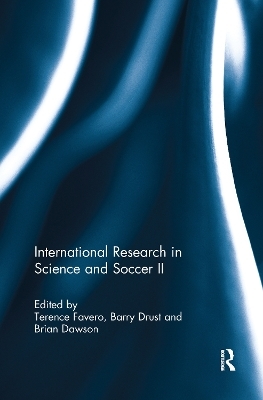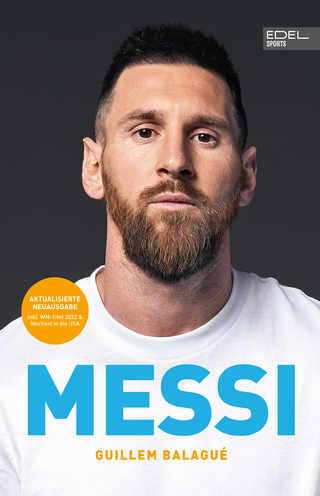
International Research in Science and Soccer II
Routledge (Verlag)
978-1-138-08795-8 (ISBN)
International Research in Science and Soccer II showcases the very latest research into the world’s most widely played sport. With contributions from scientists, researchers and practitioners working at every level of the game, from grassroots to elite level, the book covers every key aspect of preparation and performance, including:
• performance and match analysis;
• training and testing;
• physiotherapy and injury prevention;
• biomechanics;
• youth development;
• women’s soccer;
• sport science and coaching;
• sport psychology.
Sports scientists, trainers, coaches, physiotherapists, medical doctors, psychologists, educational officers and professionals working in soccer will find this in-depth, comprehensive volume an essential and up-to-date resource.
The chapters contained within this volume were first presented at The Fourth World Conference on Science and Soccer, held in Portland, Oregon, in June 2014 under the auspices of the World Commission of Science and Sports.
Terence Favero is President of the Fourth World Conference on Science and Soccer and Professor of Biology and an Associate Dean for Faculty at the University of Portland, Oregon, USA. Barry Drust is Professor of Applied Exercise Physiology at Liverpool John Moores University, UK. Brian Dawson is Winthrop Professor in Sport and Exercise Physiology in the School of Sports Science, Exercise and Health at the University of Western Australia.
PART I Match Analysis 1. Changing the Ratio of Area Per Player During Small-Sided Soccer Games Shapes Performance 2. Possession with Purpose: A Data-Driven Approach to Evaluating Team Effectiveness in Attack and Defense 3. Positional Role Influences Soccer Tactical Performance 4. Substitution Patterns and Analysis in Men’s Division I College Soccer 5. Substitution Patterns in Women’s Division I College Soccer: Game Strategy or Fatigue Prevention 6. Tactical Analysis of Barcelona, Inter Milan and Manchester United Counterattack - A Mixed Method Approach 7. Using Positional Data to Analyze Tactical Behavior in Soccer Matches PART II Exercise Physiology 8. Effect of Nitrate Gels on Repeated Sprint Performance and Recovery 9. Physical Demands of Regular Season and Playoff Matches in Professional Women’s Soccer: A Pilot from the Female Athletes in Motion (FAiM) Study. 10. GPS Performance Analysis of Women’s Soccer Competitive Matches of the Second and Fourth German Leagues 11. Salivary Cortisol is Highly Correlated With Training Intensity in English Premier League Players 12. Effectiveness of Treadmill Versus Ground-Based Repeated Sprint Training on Sprint Time and High-Intensity Running Ability in Youth Female Soccer Players 13. Heart Rate- Versus Speed-Based High-Intensity Interval Training in Young Soccer Players PART III Sports Medicine 14. Neurocognitive Changes in Men’s and Women’s Soccer Players Across a Collegiate Career 15. Systematic Development of Fitness for Return to Play From Lower Extremity Injury. 16. New Insights in Concussion Diagnosis, Evaluation and Rehabilitation 17. Bone Health and Intermuscular Adipose Tissue-Free Skeletal Muscle Mass in Costa Rican Football Players 18. Relationship Between Injuries and Somatic Maturation in Highly Trained Youth Soccer Players PART IV Sport Psychology, Youth Development and Coaching 19. A Scale to Measure the Complexity of Game Situations in Soccer 20. Decision Making and Tactical Knowledge: An Australian Perspective in the Development of Youth Football Players 21. Analyzing and Reconciling Models of Youth Development in American Soccer: People Versus Performance 22. The Ultimate Goal: Achieving Optimal Collegiate Women’s Soccer Performance Through Promotion of Sport Enjoyment 23. Gender Differences in Participant Motivation in Masters Football at the 2010 Pan Pacific Masters Games 24. What does a Football Player’s Cultural Capital Say About Their Prospects? PART V Biomechanics and Technological Tools 25. Development of a Semi-Automatic Tracking System for Soccer Players by Using Particle Filter 26. A Method of Measuring the Linear and Angular Kinematics of a Soccer Ball in Flight PART VI Performance Profiling 27. Prognostic Validity of Motor Diagnostics in the German Talent Identification and Development Program 28. The Influence of Maturation, Physical Capacity, Technical Ability and Motor Competence on Playing Level and Position in Youth Soccer Players 29. Analysis of Vertical Jump Parameters with Respect to Age, Jump Type and Bilateral Differences in Young Soccer Players 30. Comparison of Locomotive Classifications between Central and External Defenders in Elite Youth Soccer Players 31. Lower-Extremity Strength Profile of Elite Youth Soccer Players
| Erscheinungsdatum | 01.06.2017 |
|---|---|
| Zusatzinfo | 48 Tables, black and white; 54 Line drawings, black and white; 4 Halftones, black and white; 106 Illustrations, black and white |
| Verlagsort | London |
| Sprache | englisch |
| Maße | 156 x 234 mm |
| Gewicht | 453 g |
| Themenwelt | Sport ► Ballsport ► Fußball |
| Studium ► 1. Studienabschnitt (Vorklinik) ► Physiologie | |
| Naturwissenschaften ► Biologie ► Biochemie | |
| ISBN-10 | 1-138-08795-5 / 1138087955 |
| ISBN-13 | 978-1-138-08795-8 / 9781138087958 |
| Zustand | Neuware |
| Haben Sie eine Frage zum Produkt? |
aus dem Bereich


